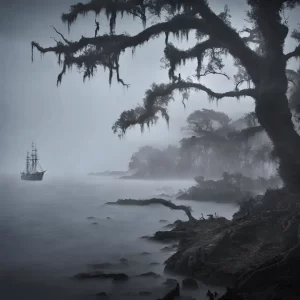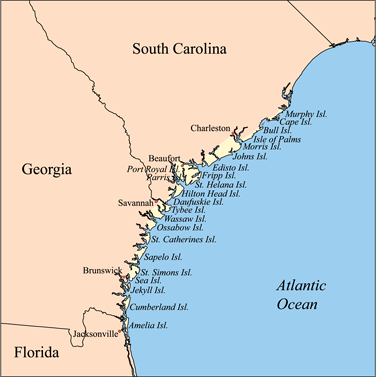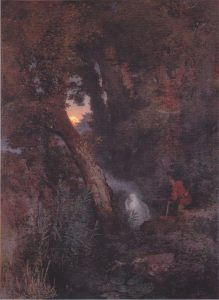Ghosts Of Oatland Island

Oatland Island is part of a chain of landmasses called the Sea Islands that pepper the Southeastern Coast of the United States. There are over 100 of these barrier islands. Most are located between Santee and St. Johns Rivers along the coast of the US states of South Carolina, Georgia, and Florida. And most, due to their history, is littered with a specter or two… Hauntings that predate European Settlements, hauntings that encompass legendary slave revolts, and hauntings that are linked to pirates, brigands, and maritime madmen. What makes the ghosts of Oatland Island so unique, among this macabre of menagerie, is that its haunts and terror-soaked tales are fairly modern… most chained to horrors of WWII and off-the-book medical experiments.
The History of the Sea Islands

Settled by autochthonous civilizations over thousands of years, the islands were chosen by Spanish pilgrims as sites for the founding of colonial missions. Historically, the Spanish ruled, turned, influenced, and manipulated the Guale and Mocama chiefdoms by ascertaining their Christian beliefs in the area and all but whipping out native pagan traditions.
The mission system closed shop under the battering pressure of repeated raids by the English in South Carolina, Pirate attacks, and Indian incursions. The Crown in England had crafted an alliance between their forces and those of pirates and local Indians; in essence, the Brits were bankrolling all the ruffians, making mince meat of the missionaries.
The Spanish, sick and tired of burying priests, seceded most of the land to the Brits. After the 18th-century European-American foundation of Georgia and Florida, farmers bought and enslaved Africans for labor. Many were used to work the labor-intensive plantations on the Sea Islands. A great deal of the wealth generated in the area financed the Crown’s development of the 13 Colonies. Once the Revolutionary War ended, this economic system continued.
During the American Civil War, the Union Navy and the Union Army soon invaded the islands. The white planter families had fled to other locations on the continent, oftentimes abandoning their slaves. The slaves chiefly ran their own lives throughout this period. They crafted a cohesive and were divorced from the troubles plaguing the mainland. “Polite society” avoided the island, afraid of the “negroes” and the tales – most fake and famed by crafty slaves – of rampant malaria in the area.
After President Abraham Lincoln’s Emancipation Proclamation was validated on January 1, 1863, more than 5,000 slaves on Union-occupied islands obtained their freedom.
History Of Oatland Island
That’s part one… Now, let’s talk about Oatland Island.
From the 18th to mid-19th centuries, Oatland Island was part of a burgeoning cotton hacienda, and the archipelago was cleared and used as farmland. The ranch home was not on the island.
The land was privately owned until 1927, when it was acquired by the Order of Railway Conductors as the place of a new retirement center for the union’s members. The Conductors’ Lodge opened shop in 1927 and had enough room to house 66 residents… It never took off. The dwindling numbers of residents, the overwhelming cost of making the place function properly, and the constant barrage of hurricanes made it a nightmare to run. In 1940, it had no other choice but to close its doors.
The conductors sold the property to the US Public Health Service in 1941… Here’s where things get interesting.
The home was transformed overnight into a research hospital for women and children with syphilis and other sexually transferred diseases. For over 5 years, until 1945, when penicillin became readily available, all manner of madness and rumors of what happened within the hospital’s walls were whispered through the grapevine, none too heartwarming.
The hospital finally closed, and the few patients it had transferred elsewhere. In 1946, the ownership hanged hands, and the deed was filed inside the cabinet of a different branch of the Public Health Service, the Malaria Control in War Areas (MCWA) division.
The building was converted into their Technical Development Laboratory. A year later, malaria wasn’t enough so the MCWA broadened its scope and became the agency we nowadays know as the CDC (Center for Disease Control).
At the Oatland lab, the CDC examined insect and airborne infections, mosquito control, and the use of DDT as a pesticide. For more than 25 years, the CDC has conducted all manner of madcap experiments on Oatland. In 1973, the CDC moved its labs to its headquarters in Atlanta… And immediately afterward, what did the building transform into… A SCHOOL. From a slave farm to old folks home, to a syphilis hospital, to a secret government lab’, to a SCHOOL. Makes perfect sense. Is it any wonder you’re reading an article called Ghosts of Oatland Island?
It stayed a school, part of the area’s educational mission for over 30 years. In 2004, the property was once more transferred. It became a Wildlife Center and, as of 2009, one of the area’s most prestigious veterinary clinics.
Ghosts of Oatland Island
One of the most famous accounts of the ghosts of Oatland Island can be found in Beth Dolgner’s Georgia Spirits and Specters. Since the book came out, researchers on the subject have basically flooded the wildlife center and set up shop there. The Ghosts of Oatland Island are one of the most pernicious and widespread legends in the Savanah territory. The place, over time, has developed a cult following, mostly of haunted house enthusiasts, on account of its ghost-riddled hospital/plantation/school.
Ever since the strange happenings of WWII and the bizarre experiments conducted there by the CDC and before that MWCA and before that syphilis research/hospital board, the island has been plagued by phantoms and all manner of bogeymen. Some of the experiments have been documented; others meanwhile were either lost to time or swept under the rug by the federal stooges of the moment. Oversight in those days was a pipedream, and the perils of such a place as this were widely known but never discussed in polite society; for too many, it was a necessary evil. During its period as a school, kids would joke that you could hear the sound of shrieks and bedeviled moans coming from certain walls. The history of the place is one swallowed up in all manner of awfulness… Slaves, patients, lab rats, the clincher, maybe even pirates, and a murder or two. The islands have a sketchy history, one whose details are lost to time.

Visitors and tour guides have constantly reported all manner of supernatural shenanigans in the area. One of the most common events in the main structure – the old rail conductors home – are will-o’-the-wisp, will-o’-wisp, or ignis fatuus. This phenomenon is known in the fringe science community as atmospheric ghost light. They are typically seen by travelers at night, particularly over bogs, swamps, or marshes. The phenomenon is associated with English folk beliefs and much European folklore. In ancient tales, these orbs are either restless spirits or fairies; mind you, evil, cunning fairies that want to lead you astray. On Oatland Island, there are supposedly orbs that flicker all over the place… large… small… bright… dull… multicolor. They come in all shapes and sizes. The main hotspot for them is the facility. There are dozens of videos online of the phenomenon.
Another rather widespread supernatural event is Electronic Voice Phenomena, or “EVP”. Research within the structure of this phenomenon has unearthed white noise, static, spiritual voices, and spooky, undecipherable messages from the other side.
Due to the appearance of these events, hundreds of dark tourism enthusiasts have decided to play ghost hunter. The area is constantly besieged by would-be ghostbusters. Scores of them with all manner of equipment: cameras, audio recording devices, video hardware, laptops, and the occasional tin foil hat. YouTube, Facebook, and dozens of blogs on the net are floated with transcripts of the many supernatural phenomena experienced there. Thousands of ghost pictures and ghost videos. Innumerable recordings have managed to capture all manner of scary noises and unexplained sounds… even conversations and wild, savage screams.
A scroll through YouTube’s library of videos will unearth multiple scenes of Blair Witch-like horseplay. Some are too grainy to make out, others in HD glory. Without a doubt, the islands that pepper the East Coast of the United States are inundated with phantasmagoria and thousands of ghosts. Places beseeched by the dead, by tragedies, by sunken ships, slaves in panic, and by gruesome government experiments.
For more spooky tales, check out our blog.
Sources:

